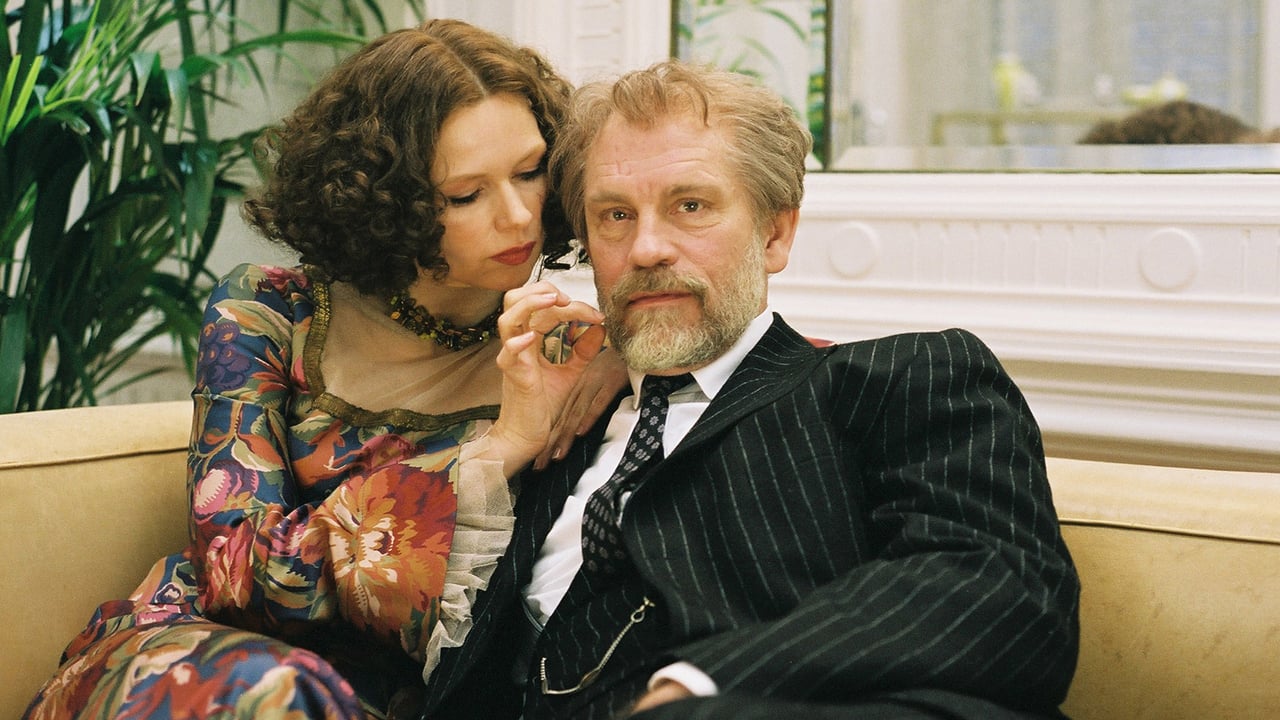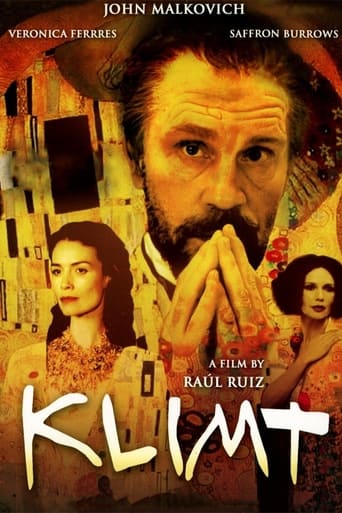

People are voting emotionally.
... View Morebrilliant actors, brilliant editing
... View MoreGreat story, amazing characters, superb action, enthralling cinematography. Yes, this is something I am glad I spent money on.
... View MoreOne of the film's great tricks is that, for a time, you think it will go down a rabbit hole of unrealistic glorification.
... View MoreKlimt (2006)John Malkovich is talented but so quirky and full of himself he nearly ruins many of his movies. Surely he sees how affected he can sometimes be? Here he plays the Austrian artist Gustav Klimt in the years before WWI, and though we don't quite know what Klimt was like, we know he didn't play his life being John Malkovich. Biopics always struggle with the character against the actor, of course, since history is what it is, and so you swallow all this and see what the actor and the director can do within these constraints.The director in this case is the late Raul Ruiz, the Chilean director who just died in Paris with a small cult following and a growing reputation. He concentrates not on Klimt's art, or even Klimt's attitudes as an artist of his time (this is the time of early Picasso, late Cezanne, and the growing influence of Gauguin). Instead it deals with Klimt's personality, which we know the least about, emphasizing his vulgarity, his obsession with nude women around him as much as possible, and his countless children for whom he apparently did as little as possible.What might have been more interesting is to see a young Klimt being transformed by a 6th century Italian fresco with all its gold leafwork (this is true), or to maybe see him interact with the Vienna Secessionists in their effort, as a group, to break from the academy. What we get instead is a fantasy about the women around him, including a bizarre and willing entrapment of Klimt by a wealthy woman and her double (or twin?) which turns into a kind of erotic sex game with a man watching behind 2-way glass. Then there is a mysterious fellow who seems to only exist in Klimt's head--he's fascinating, yet only half realized. If Ruiz had taken all this into something purely fantastic, where the trappings of history were shed, it might have been a transporting and special movie, an actual cinematic experience on its own terms. At times it tries, and there are some distortions and some beautiful moments, a bit out of place in the narrative, that stand on their own.But mostly this lurches and jerks from situation to situation. The art is great, what we see of it, and the sets are nice, though even they are filmed too often with a yellowed dullness that defies the outrageous decorative beauty of the time. (I just happened to see "The Wings of the Dove" set in the same period and the set and costume design blows "Klimt" away). All of this is too bad especially for an art movie about an artist who believed in total aesthetic immersion--where everything, including your toilet paper holder, had to be an artistic component of a life of art. It's not a disaster, but it's certainly a feminist's nightmare--where Klimt might have defended his painting of women as being honest and where the sex might have been free expression and liberation, the movie pushes all this into pure voyeurism and submissiveness. Women dangle and prance and decorate the movie sets, and your screen, the way Klimt, who was no feminist, might have approved, but which isn't accurate. It isn't about an equality in free loving sex, it's about women from a man's point of view. Period. Some of you will like that, but I did not.
... View Moreone of the worst, if not the worst movie I have seen in a long long time- what a waste of time- absolutely and completely moronic, dull, listless, pointless, stupid-film contains characters who appear/disappear for no reason, and even worse, where you have no idea who they are, or why they are there- film also uses the "imaginary person" technique, where Klimt talks to someone only he can see- why? what is this about, what is this for-my question is, how does stuff like this even get made- doesn't anyone in the process bother to read the script?- things this bad are actually very obvious to anyone in the production process- I mean if you read a bad script, you know it!-this movie is so BAD, and so full of nonsense I can't imagine how it got made, which is the funny part because when you look at the "Making of Klimt" in the 'extras' section of the DVD, you see all these egg-head types sitting around discussing the "vision" thing- talk about the blink leading the blind and stupid- AVOID this movie -
... View MoreThis is a superb movie; IF (and this is a big if) one is already familiar with the life and work of Gustav Klimt. This movie was intended as an "art house" film, and was never meant to be a major theatrical release. However, even for an "art house" film it is rather specialized in how it portrays Gustav Klimt; and if one is not familiar with this artist (and Vienna at the turn of the 20th century) then this film is quite confusing and vague- the quantity and quality of female imagery notwithstanding. Despite its very specialized nature some major stars are in this film though only one is an American and even he lives and works mainly in Europe. That star is John Malkovich; who is in the title role. Malkovich gives a fine job though he does not resemble Klimt as closely as some other actors who have portrayed Klimt in the past (most notably August Schmolzer in "Bride of the Wind"). The only other actor in this film that may be recognized by Americans is Saffron Burrows; who portrays his great love interest. Her role is fictional, but serves as a continuity thread through this film which depicts in an allegorical manner his career and life from 1900; when Klimt won a gold medal at the great Paris Exposition to 1918; when he died.The other actors are notable European actors whose works have generally not been seen in the United States. The notable German actress Veronica Ferres portrays Emily Floge; Klimt's lifelong companion. Again, unless you are familiar with the life of Klimt the role of Floge in this movie is very difficult to understand. And, it is never explained in the movie. Basically, Klimt and Floge were in-laws by the marriage of Gustav's brother to Emily's sister. The seemed to never have been "lovers" but the unmarried Emily seems to have been a wife (as well as business partner) to Gustav in every other respect. It was a complex relationship and Ferres explains in a side featurette ("The Making of Klimt") the difficulty of showing this relationship. The Austrian actress Aglaia Szyszkowitz portrays "Mizzi"; a model who bore two kids for Klimt of which one is shown- his son Gustav. He never married her, and the movie implies that he saw his kids only occasionally without financially supporting them in any noticeable manner. In real life Klimt did financially support his children by this woman. Of note is that the nickname for Emily Floge was "Middi" and the pronunciation of the two names is very similar; adding to the already considerable confusion.The movie does portray Klimt in a negative manner concerning his offspring. He acknowledged paternity of four children and the movies deals with the other two as well as the two of Mizzi. Those children are dealt with almost as afterthoughts and one is positively embarrassing (perhaps the ultimate embarrassment). In reality Klimt probably had many more kids and this concern is mentioned briefly in the film. The film is certainly critical of Klimt in this regard; as well as his attitude towards women in general. There are some historical inaccuracies in this film such as a nurse in a Vienna hospital in early 1918 who has a VERY obvious British accent. This is highly unlikely, to say the least, to have been the case considering that the Austrians were in war with the British at that point, but overall the historical settings and costumes are well researched. The movie overall is well researched, but, again, quite confusing to somebody who is not very familiar with the life of this genius. I recommend that anybody who wants to see the film to first read up and look at the artworks of Klimt. Then the film will make sense and be seen as the superb achievement it is.
... View MoreI am a very generous person when it comes to criticism. But seriously... I expected to learn something about this man and walked away confused and emotionally dead...actually, quite frustrated. Perhaps I'm spoiled by films that have a plot and films that clearly let you know why a character is doing something. I had no idea why Klimt was doing ANYTHING. What did he want? Who did he want? I understand very, very little about this man and what he cared about and what motivated him. Every female character looked too much like the other, I couldn't even tell who the object of his desires was! I'm actually considering another 20 minute bike ride in the past-midnight Tokyo winter to rent another film just to leave myself satisfied...Jeez...
... View More